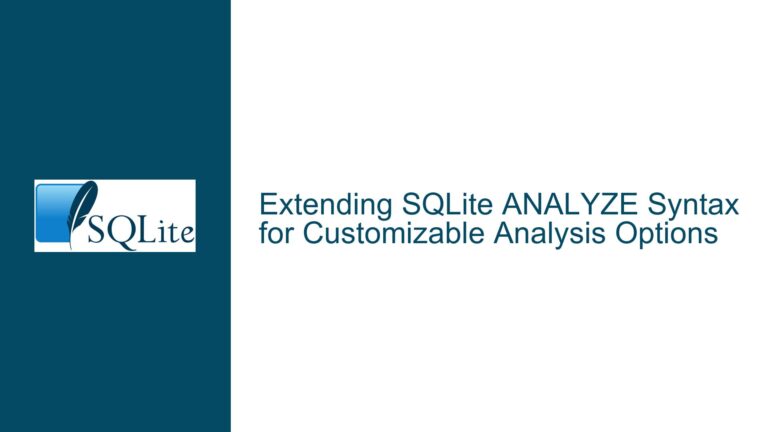Temporary Data Handling in SQLite When Running Out of Memory
SQLite Temporary Storage Behavior Under Memory Constraints
When working with SQLite, understanding how temporary data is managed under memory constraints is crucial for ensuring both performance and reliability. Temporary data in SQLite includes intermediate results from queries, sorting operations, and other transient data structures that are necessary for query execution but do not need to persist beyond the scope of the operation. The behavior of SQLite when handling temporary data, particularly when the system runs out of main memory, is influenced by several factors, including the SQLITE_TEMP_STORE compilation option and the underlying operating system’s memory management policies.
The SQLITE_TEMP_STORE compilation option is a compile-time setting that determines how SQLite handles temporary storage. When set to 2 or 3, SQLite is instructed to use memory for temporary storage, bypassing its own mechanisms for managing temporary files on disk. This can lead to scenarios where the system runs out of memory, especially during large or complex operations that generate significant amounts of temporary data. In such cases, the behavior of SQLite and the operating system becomes critical in determining whether the application will continue to function or encounter errors.
The interaction between SQLite and the operating system’s memory management is complex. When SQLite is configured to use memory for temporary storage, it relies on the standard C library’s memory allocation functions, such as malloc, to obtain the necessary memory. The operating system then manages this memory according to its own policies, which may include swapping memory to disk if the system runs out of physical RAM. However, if the memory allocated by SQLite is marked as non-swappable, the operating system may not be able to swap it out, leading to potential out-of-memory conditions.
Understanding these interactions is essential for database developers and system administrators who need to optimize SQLite’s performance and ensure that their applications can handle large datasets without running into memory-related issues. This post will explore the possible causes of memory exhaustion in SQLite when using temporary storage, and provide detailed troubleshooting steps and solutions to mitigate these issues.
Memory Allocation and Operating System Swapping Mechanisms
The behavior of SQLite when running out of memory is heavily influenced by how memory is allocated and managed by both SQLite and the operating system. When SQLITE_TEMP_STORE is set to 2 or 3, SQLite allocates memory for temporary storage using the standard C library’s malloc function. This memory is then managed by the operating system, which may employ various strategies to handle memory allocation and swapping.
One of the key factors in this process is whether the memory allocated by SQLite is marked as swappable or non-swappable. Swappable memory can be written to disk by the operating system when the system runs out of physical RAM, allowing the system to free up memory for other processes. Non-swappable memory, on the other hand, cannot be written to disk and must remain in physical RAM. If SQLite allocates non-swappable memory for temporary storage, the operating system will not be able to swap it out, potentially leading to out-of-memory conditions if the system runs out of physical RAM.
The operating system’s memory management policies also play a significant role in determining how memory is allocated and swapped. Different operating systems have different mechanisms for managing memory, and these mechanisms can affect how SQLite behaves when running out of memory. For example, some operating systems may prioritize certain types of memory allocations over others, or may have different thresholds for when memory is swapped to disk.
In addition to the operating system’s memory management policies, the amount of physical RAM available on the system also affects SQLite’s behavior. Systems with limited physical RAM are more likely to run out of memory when SQLite is configured to use memory for temporary storage, especially if the memory is non-swappable. In such cases, the operating system may be forced to terminate processes or take other drastic measures to free up memory, potentially leading to application crashes or data corruption.
Understanding these factors is essential for troubleshooting memory-related issues in SQLite. By understanding how memory is allocated and managed by both SQLite and the operating system, developers and system administrators can take steps to optimize memory usage and prevent out-of-memory conditions.
Optimizing SQLite Temporary Storage and Memory Usage
To mitigate the risks associated with running out of memory when using SQLite for temporary storage, several strategies can be employed. These strategies include optimizing SQLite’s configuration, adjusting the operating system’s memory management settings, and implementing best practices for memory usage in applications.
One of the most effective ways to optimize SQLite’s temporary storage behavior is to adjust the SQLITE_TEMP_STORE compilation option. By setting SQLITE_TEMP_STORE to 1, SQLite will use a combination of memory and disk for temporary storage, allowing it to fall back to disk if memory becomes scarce. This can help prevent out-of-memory conditions by ensuring that temporary data can be written to disk if necessary.
Another important consideration is the use of the temp_store PRAGMA. The temp_store PRAGMA allows developers to control how SQLite handles temporary storage at runtime, providing more flexibility than the SQLITE_TEMP_STORE compilation option. By setting temp_store to FILE, developers can instruct SQLite to use disk-based storage for temporary data, reducing the risk of running out of memory. Alternatively, setting temp_store to MEMORY can improve performance by using memory for temporary storage, but this should be done with caution and only when sufficient memory is available.
In addition to adjusting SQLite’s configuration, developers can also optimize their applications to reduce the amount of temporary data generated. This can be achieved by optimizing queries to minimize the use of intermediate results, using appropriate indexes to speed up query execution, and avoiding unnecessary sorting operations. By reducing the amount of temporary data generated, developers can reduce the risk of running out of memory and improve overall application performance.
Finally, it is important to monitor memory usage and take proactive steps to prevent out-of-memory conditions. This can include monitoring the amount of memory used by SQLite and other processes, adjusting the operating system’s memory management settings to prioritize SQLite’s memory allocations, and implementing mechanisms to handle out-of-memory conditions gracefully. By taking these steps, developers can ensure that their applications remain stable and performant even when dealing with large datasets and complex queries.
In conclusion, understanding how SQLite handles temporary storage under memory constraints is essential for optimizing performance and preventing out-of-memory conditions. By adjusting SQLite’s configuration, optimizing application code, and monitoring memory usage, developers can ensure that their applications remain stable and performant even when dealing with large datasets and complex queries.






